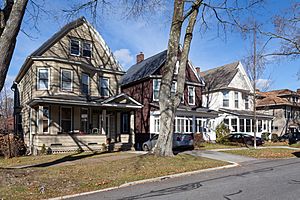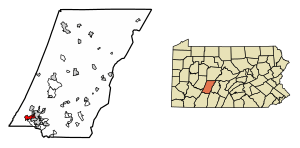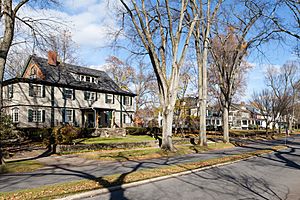Westmont, Pennsylvania facts for kids
Quick facts for kids
Westmont, Pennsylvania
|
|
|---|---|

Tioga Street homes, built in 1901
|
|

Location of Westmont in Cambria County, Pennsylvania.
|
|
| Country | United States |
| State | Pennsylvania |
| County | Cambria |
| Settled | 1788 |
| Incorporated | 1892 |
| Area | |
| • Total | 2.37 sq mi (6.13 km2) |
| • Land | 2.37 sq mi (6.13 km2) |
| • Water | 0.00 sq mi (0.00 km2) |
| Elevation | 1,752 ft (534 m) |
| Population
(2020)
|
|
| • Total | 4,982 |
| • Density | 2,106.55/sq mi (813.31/km2) |
| Time zone | UTC-5 (EST) |
| • Summer (DST) | UTC-4 (EDT) |
| FIPS code | 42-83584 |
| GNIS feature ID | 1215038 |
Westmont is a town, called a borough, in Cambria County, Pennsylvania, USA. It is part of the larger Johnstown, Pennsylvania area. In 2020, about 4,982 people lived there.
Westmont's Location
Westmont is in the southwestern part of Cambria County. It is next to the city of Johnstown on the east. To the north is the town of Brownstown. To the south are the town of Southmont and the area of Elim.
Westmont sits high up, about 700 feet above the Stonycreek and Conemaugh River valleys. These valleys are in the middle of Johnstown. The total area of Westmont is about 6.1 square kilometers (2.37 square miles), and it is all land.
Westmont's History
Before a big flood in 1889, the area where Westmont is now was mostly farms. The roads were steep and muddy. After the Johnstown Flood of 1889, the city of Johnstown was badly damaged. The main employer, the Cambria Iron Company, decided to build a new neighborhood for its top workers. This new area would be on top of a hill.
The company hired a famous landscape architect, Charles Miller. He designed the streets for the new settlement, which was first called "Tiptop." Later, it was renamed Westmont. Westmont was built on a ridge high above the valley. This made it a safe place, away from the smoke, noise, and smells of the city below. Many wealthy people wanted to move there.
To make travel easy, an inclined railway called the Johnstown Inclined Plane was built. This railway helped people get to the city quickly. With good transportation, Westmont grew fast. It officially became the Borough of Westmont on June 13, 1892. In 1935, the town bought the inclined railway.
Later, in 1938, buses started running to Westmont. They even rode up and down the Inclined Plane. Over time, a new highway called Menoher Boulevard (PA Route 271) was built. This made it easier to get to Westmont from downtown Johnstown. Bus service then moved to this new road, and buses stopped using the Inclined Plane.
Because Westmont is on high ground, it was safe from later floods that hit Johnstown.
A person from Westmont was the first American soldier to die in the Vietnam War. Captain Harry Griffith Cramer Jr. lived on Luzerne Street. He graduated from West Point in 1946. He was a brave soldier and led the first team of US Special Forces advisers in Vietnam. He died on October 21, 1957.
The Westmont Historic District was added to the National Register of Historic Places in 1995. This means it is a special place with important historical buildings.
Westmont Today
Westmont still has many beautiful, large, old houses. Today, about 5,000 people live in Westmont.
Westmont is run by a "Weak Mayor-Council" government. This means there are seven council members and a mayor. Voters choose them for four-year terms. The mayor only votes if there is a tie. The council makes the town's rules and approves officials. The daily work is managed by the borough secretary and the public works director.
Westmont has a volunteer fire company and an ambulance service. The West Hills Regional Police Department provides police protection.
Even though Westmont is much bigger now, it still feels like the quiet, tree-lined community it was meant to be. You can often see people jogging, walking, and children playing. The town still has rules against too many businesses.
One of the most special things about Westmont is the street of American elm trees along Luzerne Street. This street is known as the last "cathedral-arched boulevard" in the United States. There are 195 elm trees, making it the longest continuous line of American elms in the country. Westmont takes great care of these trees to protect them from Dutch elm disease.
Population Information
| Historical population | |||
|---|---|---|---|
| Census | Pop. | %± | |
| 1900 | 499 | — | |
| 1910 | 1,468 | 194.2% | |
| 1920 | 1,976 | 34.6% | |
| 1930 | 3,388 | 71.5% | |
| 1940 | 3,741 | 10.4% | |
| 1950 | 4,410 | 17.9% | |
| 1960 | 6,573 | 49.0% | |
| 1970 | 6,673 | 1.5% | |
| 1980 | 6,113 | −8.4% | |
| 1990 | 5,789 | −5.3% | |
| 2000 | 5,523 | −4.6% | |
| 2010 | 5,181 | −6.2% | |
| 2020 | 4,982 | −3.8% | |
| U.S. Decennial Census | |||
In 2000, there were 5,523 people living in Westmont. Most people were White (97.59%). There were also smaller groups of African American, Native American, and Asian people. About 0.91% of the population was Hispanic or Latino.
The average age of people in Westmont was 44 years old. About 24.4% of the population was under 18. About 20% of the population was 65 or older.
The average income for a family in Westmont was about $64,185. A small number of families and people lived below the poverty line.
See also
 In Spanish: Westmont (Pensilvania) para niños
In Spanish: Westmont (Pensilvania) para niños



